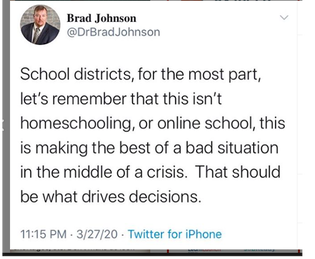 from Elizabeth | Seneca Falls, NY I am a graduate student from Buffalo State, currently completing my student teaching through remote instruction, with the guidance of my teacher-mentor, in Rochester, NY. Earlier this week I happened upon this post at @teachersconnect: School districts, for the most part, let's remember that this isn't homeschooling, or online school, this is making the best of a bad situation in the middle of a crisis. That should be what drives decisions. I find this quote to be insightful because we are, in fact, in the middle of a crisis. I have felt a little discouraged these past two weeks wondering: Why are only a few parents responding to my outreach? Why have only 4 out of 21 students turned in their assignments? And so forth. I kept thinking that it must be me. I made interactive and engaging videos that were sent home. I came up with fun activities for the students to do with their families. But still...only a couple responses. The quote put things in perspective for me. A crisis. A pandemic. A very scary and uncertain time. Students are facing a huge change in their life, especially the little ones who need routine. They are overwhelmed. Parents and families are becoming unemployed and not all of them will be able to receive unemployment. They must find a way to provide for their family while trying to teach their child or children the lessons we have been sending home. They are overwhelmed. My school was closed right at the 8 week mark of my student teaching placement. Since I am still student teaching, there are certain things I must complete and submit in order to become certified. As I frantically try to get all the pieces together, I also learned to step back and took a breather. I am overwhelmed. As an educator, it is my duty to make sure that the children are receiving the education to which they are not only entitled, but also deserve. I am doing the best I can to ensure that my families have the resources they need. I continue to send home engaging videos and resources and activities, but I am not getting down on myself or feeling as though I am not doing enough. We are in the middle of a crisis. To the teachers out there I say...
These may seem like small successes when we compare them to what the outcome would be if we were still in our schools. But we are not in our schools. We are at home in the middle of a crisis doing the best that we can. The most important thing right now is the health, safety, and mental well-being of our students, families, community...and don't forget yourself! Step back, take a deep breath, and know everything will work out in the end. Make the best out of this bad situation.
1 Comment
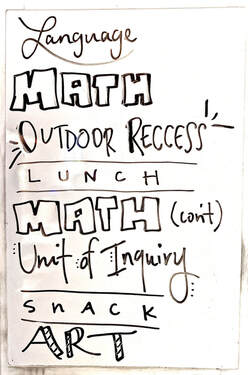 from Molly | Buffalo, NY International Baccalaureate (IB) is an educational philosophy for students ages 3-18 that values student agency, inquiry-based learning, and intercultural understanding to inspire lifelong learners. The ideal IB classroom gives students ownership of their own schedule, with no blocked off times because all subjects areas are meant to be transdisciplinary and connected. The following tips are ways you can incorporate some of the IB principles into your own learning routine and rhythm at home:
from Amanda | Rochester, NY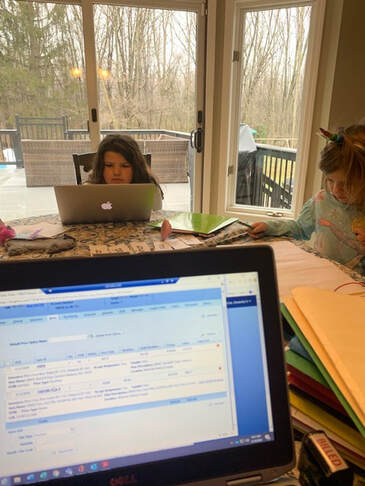 During this time at home due to the current COVID-19 outbreak, I have created a schedule to help with everyday life. My husband and I both work full time and we have both had to continue our jobs full time. Luckily, my job as a medical biller enables me to remotely from home. The challenging part was how do I juggle work along with keeping my kids on a daily schedule. As I started this I have learned quickly what works and whats doesn't. Every night I now make a lesson plan based on the work that their teachers have provided. Weekly assignments are sent out each week for my fourth grader, whereas my first grader receives a day-to-day schedule. Every morning we start with breakfast, then begin literacy immediately afterwards. For my fourth grader we use i-Ready and SpellingCity, or any articles that her teacher assigns. For my first grader we begin with a read aloud book that was assigned. We then move on to math. For my fourth grader this consists of 10 minutes of Moby Max, as well as any other assignments that were assigned. For my first grader we use SplashLearn (formerly SplashMath), or we complete an exercise that involves counting everyday objects found around the home. Around 11:00am everyday I have the girls read to our Goldendoodle, Morgan. After that, lunch and then Lunchtime Doodles with Mo Willems. In the afternoon we begin to wind down and outdoor time is encouraged.
My fourth grader was starting Girls on the Run, local teams that meet twice a week with volunteer coaches who inspire girls to be confident through running, but unfortunately it was canceled due to the current pandemic. Thankfully, they have provided a series of virtual videos that offer exercises and games for the young, inspiring runners. We then close with a short run to keep it up, of which I hope gets longer as she progresses in the program. My other daughter will watch a SciFi Kids video on YouTube and then plays outside, or goes on Go Noodle to end her day. Having a schedule is very important to me and my children. I feel that everyone works better with structure and organization. This way, when kids go back to school in the near future they will continue where they left off... although they will have to change out of pajamas! from Alissa Marquess at Bounceback Parenting | Posted March 11, 2020
Both adults and kids are likely feeling stress right now and it only adds to your stress when you see your child struggling. You can take the following steps to talk with your child about Coronavirus (or any stressful situation, really). Remember, you know your child best, so read through and then take what works for you. These steps are based on my training as a ICF certified coach, so they are designed to help your child find a sense of personal power in their situation. The three steps I’m outlining are:
1. Check in with how they’re feeling. You might have a sense of whether your child is anxious or not (they might not be, and that’s fine!). Either way, look for an opportunity to check in. Find a moment when you can be present with your child. Use your knowledge of their personality to choose if you want to ask around siblings or when you have a chance to check in with them alone. You might say something like, “I’m sure you’ve heard about the Coronavirus. How are you feeling about what’s going on?” Keep it simple. Just ask and then stop talking to give them a chance to respond with any thoughts, feelings or questions they might have. 2. Listen and acknowledge Don’t try and fix it, just listen. You may feel uncomfortable if you’re hearing fears and anxieties. It’s natural to want our kids to feel better! However, one of the best ways you can help your child is through active listening, rather than jumping on what their saying to try and quell those fears. Give them a chance to really offload what’s on their mind. As you listen, some good active listening replies include:
Listening without trying to fix helps expand your child’s feeling of self trust and validity. Instead of trying to whisk away their emotions by saying something like “It’ll be fine, don’t worry about it.” you’re basically saying, “I hear you and you make sense. I trust you to know your own emotions.” As you well know it doesn’t feel good to feel scared or anxious. However we are more than our emotions, we get to make choices about how we respond to our emotions. When you listen in this way it helps your child see that YOU are not scared of their emotions, and you are not getting swept away by those emotions. This provides a sense of safety. 3. Follow up with questions that invite a feeling of capability and resourcefulness. After listening and letting your child tell you everything they’re feeling right now (a great question to make sure they’ve got it all out is “Anything else?”) then you can follow up with a question that helps them tap into their own capability and resourcefulness. Remember to ask and then leave space for them to think for a while before talking any more or adding suggestions. Depending on what your child has shared with you these questions might include:
This may lead to further discussion about steps their school is taking, or questions about what your family is doing. If at any point you feel uncertain, you can always put a ‘placeholder’ in the conversation, for instance “That’s a really good question- I’m gonna research a little and let you know what I find.” You don’t have to have all the answers, but showing that you are able to take actions like researching helps kids feel safe and shows them a way to proactively problem solve. Wrap up with encouragement and gratitude. This might sound like, “You’re doing a great job washing hands. Thank for chatting with me about this, I like knowing what’s on your mind.” It’s really helpful for kids to know that it’s totally ok and not a burden on you when they share concerns with you. The truth is, we can’t pretend this isn’t a scary time. But we can be honest and talk with our kids in a way that allows them to tap into their resilience and capabilities. Sometimes these capabilities are just the capability to reach out for comfort, and at least you can give that. This kind of conversation lets you stay connected with your kids, even when you’re experiencing a stressful situation. from Wendy Paterson, Buffalo State CollegeSome helpful advice for parents who are suddenly expected to become teachers, too!
Most of these ideas are aimed at younger children who are a little more challenging to keep engaged and tend to be less self-directed than teens. Older adolescents can manage their own time, but hold them to their plans.
from Molly | Buffalo, NYWithout a doubt this is a challenging time for families, who are having to take on the role of supporting their child’s academic learning all the while cope with the stress of our current pandemic. However, in this time of social distancing and isolation, I think this is also a beautiful opportunity for self-exploration, independent learning, and personal discovery that our students do not always have the chance to experience in the classroom. Project-based and inquiry-based learning are wonderful models that allow students to explore a topic of their choosing and develop a wide range of important academic skills, such as researching, informational writing, formulating good questions, and creative thinking. Let’s be honest - motivation is at an all time low right now, especially for those who aren’t used to the level of self-motivation required in a homeschool setting. That being said, the advantage of inquiry-based learning is that it puts the student in charge of the learning process. Your child is engaged because they dive into a topic that interests them, and you sit back and act as a facilitator, coach and guide. 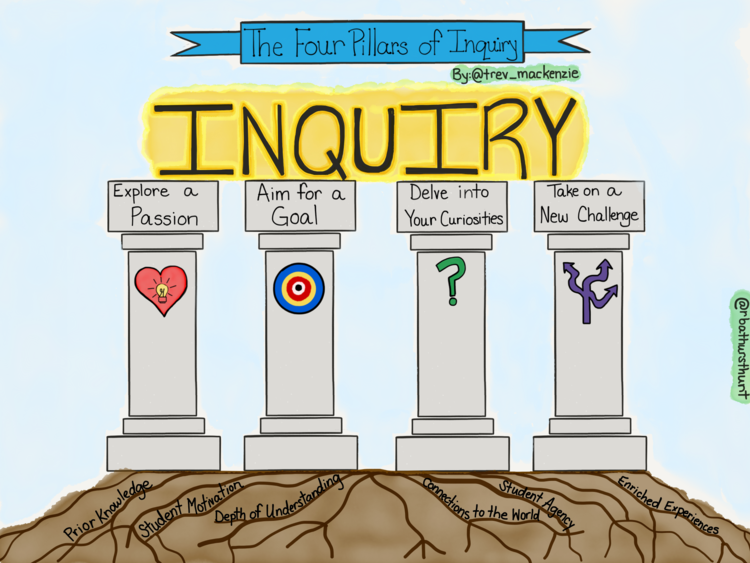 Step 1: Explore a Passion The first step in the inquiry process is to figure out a topic that your child is interested in and would like to know more about. Perhaps they have an obsession with reptiles or wooly mammoths. Maybe they can talk for hours about how computers work, or they can’t seem to stop drawing trees whenever they are given a blank piece of paper (all examples of real students I’ve worked with!). You know your child better than anyone, so guide them in a discussion to figure out a topic they would like to learn more about. Again, what a beautiful opportunity to dive deep into something that they might never have the time to explore in school! Step 2: Aim for a Goal Once you’ve picked the topic, now it’s time to focus on one key area to explore. In the project-based learning world, this is known as an essential question. Since it can be overwhelming to research big topics like reptiles and computers, to develop the essential question, first have your child brainstorm as many questions or “wonderings” that they have about the topic. Example wonderings include:
Your child will most likely come up with a long list of wonderings, some more interesting and thought-provoking than others. Pay attention to trends in their thinking to give you hints for what to focus on. For example, if they write a bunch of questions about how different reptiles eat and live, perhaps their essential question can be, “How do different reptiles survive in their environments?” Or, you or your child can choose one question from the list that you think will be the most interesting. For example, “Are computers smarter than people?” is a great one because there is not a single correct answer, and most likely will require a lot of different resources to research. Step 3: Delve into Your Curiosities Once you’ve chosen your essential question, it’s time to start the inquiry process! If you have access to technology at home, there are many online resources you can access for free. Be sure to check out the Resources page for suggestions! Whether it be videos, books and/or articles, it’s a good idea to discuss how your child will research their essential question and come up with a plan. For younger learners or those less-experienced navigating the web, they might need your guidance to select the “right” resources. If this stage of the process sounds overwhelming, don’t worry! Another beautiful thing about inquiry is that there is flexibility for change. If your child reads a bunch of books about reptiles, and finds that they are more interested in poisonous snakes, let them explore that. If your child reads about wooly mammoths and is now obsessed with dinosaurs, that’s great! The sole purpose of inquiry is not to find the answer to one question, but rather, there is joy in the inquiry process itself. Be open to whatever direction your child leads their learning! Another important aspect to keep in mind is how your child will record their findings. They can jot down notes in a journal, draw pictures, record their voice, take a video, etc. - whatever is easiest and most enjoyable for them that they will understand and be able to reference later. Step 4: Take on a New Challenge Now that your child has delved deep into a topic that interests them, they are experts! It’s time to showcase what they learned. While I enjoy many features of inquiry-based learning, perhaps my favorite is the fact that it grants students choice and autonomy over how they present their thinking. Whether it be a slideshow, video, drawing, poster, or written piece, there are endless options for students to share what they learned in a meaningful and memorable way. Perhaps your child is a visual learner, and wants to create a large scale drawing of a forest with various reptiles and their prey. Or maybe your child thrives with hands-on learning, and would love to create a diagram of a computer out of cardboard and label all the internal parts. If your child is one of those types that can’t stop moving, they could act out a play pretending to be a wooly mammoth and act out what a day in life would be. It will amaze you how much your child is capable of when they are simply given the breathing room to express their learning in a way that is comfortable and enjoyable for them. I hope these ideas make learning at home more manageable, enjoyable and comprehensible for you and your family! Here are some resources you can use to guide your inquiry projects, including articles, graphic organizers, planning tools, picture books, and visuals: https://www.trevormackenzie.com/elevate-resource https://www.trevormackenzie.com/diveintoinquiryvideos Molly Rutter is the Buffalo State School of Education Graduate Assistant. Molly has her master’s degree in Childhood Education (Grades 1-6), and this summer will complete her NYS certification in Childhood Education and Teaching English to Speakers of Other Languages (TESOL). With a particular passion for project-based and inquiry-based learning, Molly shares some creative ways you can ignite your child’s curiosity and explore their interests across any subject area.
from Tamara | Buffalo, NY 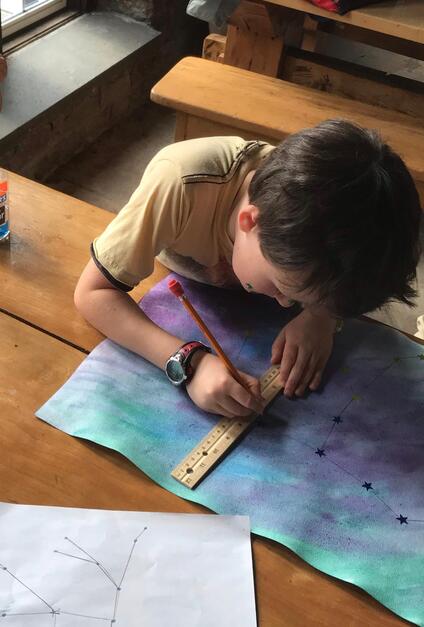 I think that one of the most important pieces for success with homeschooling - with anything - is how you start the day. Especially now, when stress levels are high and the time at home feels endless, it's really easy to sleep in late and allow more media. But this just sets up your day for frustration. Rhythm is KEY. Setting up a schedule helps kids know what to expect next and reduces arguments. Everyone likes to know what's coming next! With young kids it helps when it's not mom/dad saying what to do but the schedule says so. Older kids feel empowered to be able to take charge of their own day. The schedule should be developed to show what follows what in the morning and afternoon, and for each day of the week. Not necessarily exact times, which can just create unreasonable expectations and frustration when things don't happen at the "right" time. We first determine the big moments - breakfast, snack, lunch, snack, dinner(!) - and work everything else around these. Think FLOW. Adjust your internal clock a bit, but get up at a regular time and go through a usual routine. Even though I'm working from home now, I still help the kids get dressed and ready to meet the day. We all go downstairs for breakfast like usual and unfold into our morning routines. I even say goodbye to them (which they find hilarious) when I "leave" for work -- back upstairs to the study! A bit of a surprise to us when starting homeschooling was the realization that "lessons" don't take up the same amount of time one-on-one as they do with a group of kids in a classroom. It's basically 45 min to at most 2 hours (depending on age) of direct teacher-to-student lessons, 30-60 min of academic nourishment (experiments, board games, painting, building etc), another 30+ of reading and lots of open time for free play, exploration, nature, and just being. Another thing we realized early on is just how powerful peer-pressure and an authoritative-presence really are for holding a child's attention. I don't mean the bullying kind of peer-pressure or the abusive kind of authority. I'm referring to the kind of peer-influencing that comes from children watching their friends listening intently or following directions or working on a project...and then following suit. I'm referring to the kind of dependable and commanding leader-presence that gathers us into the circle, leaves little room for chaos, and inspires and empowers us to do better. It's good to remember that these two forces are strong in school classrooms, but are usually missing in at-home, direct-teaching spaces. Your home simply is not the same as a school and your relationship with your children is definitely not the same as what classroom teachers have with their students. So cut yourself some slack if you child "just won't pay attention" or needs lots of guiding, reminders, and re-focusing help from you. It can often seem (and is true) that you'll spend an hour prepping for an activity that is completed in 10 minutes. Expect this and you'll (hopefully) be less upset over it. The old adage of "every moment is a teaching moment" is so true. Most home school teaching isn't with desks and chalkboards, but paying attention to what's around and what your kid is curious about and building off of that with research and stories. There are a billion websites and resources being shared right now. Do a quick search and commit to just a couple resources at first...it's an unbelievably overwhelming rabbit hole and will just leave you in tears if you try to review everything, determine what's the best, and piece it all together into the "perfect" lesson. As hard as it all can feel, to be able to homeschool is also really exciting and empowering. You get the opportunity to bring to your kids the topics and adventures that are important to YOU, not just what a school or teacher has on the agenda. Even better, you get to see exactly what your kids know, how they learn, what they are interested in, what they need, and just how smart and creative they truly are. You get to see - firsthand - all those "a-ha!" and "I get it!" and "This is so neat," moments that enhance their lives and shape their interests. So cool. |
WELCOME!
Hearing from others can be the antidote to the overwhelm and stress you feel as you navigate homeschooling. Longstanding teachers, retired educators, brand new homeschooling parents and guardians, budding teacher candidates...we want to hear from you! Please contact us to share your wisdom, struggles, support, ideas, advice, empowerment, and inspiration. Archives
March 2021
Categories |
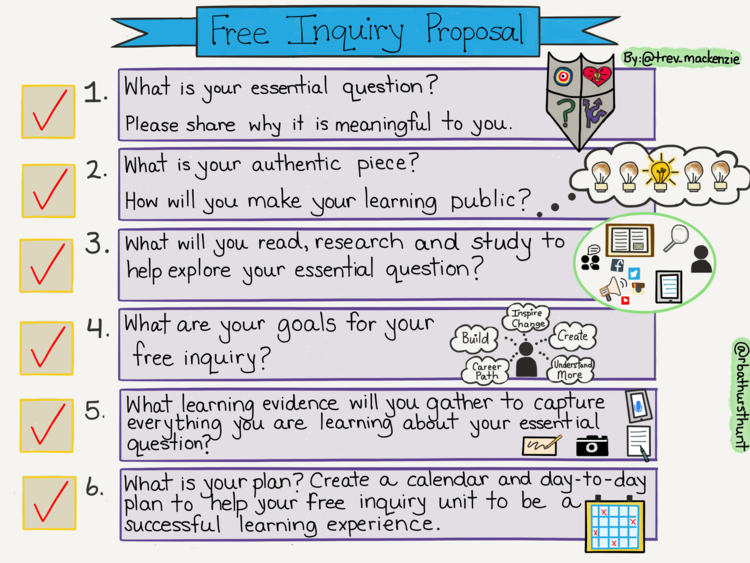
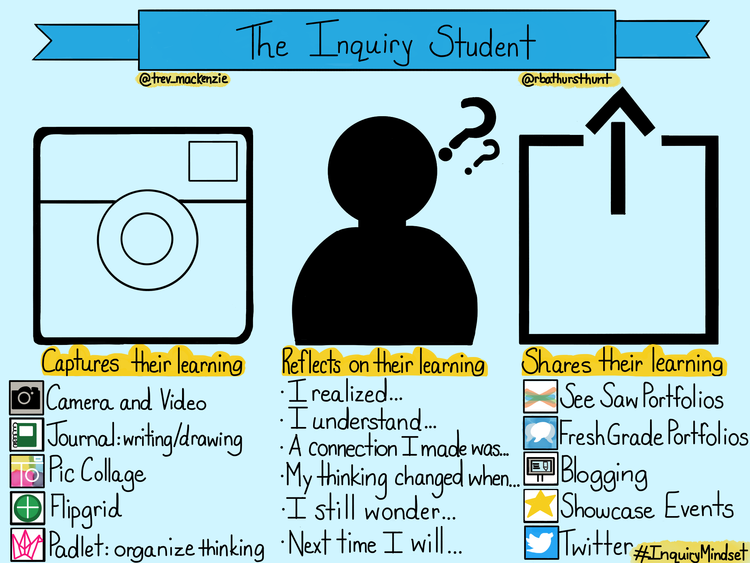
 RSS Feed
RSS Feed